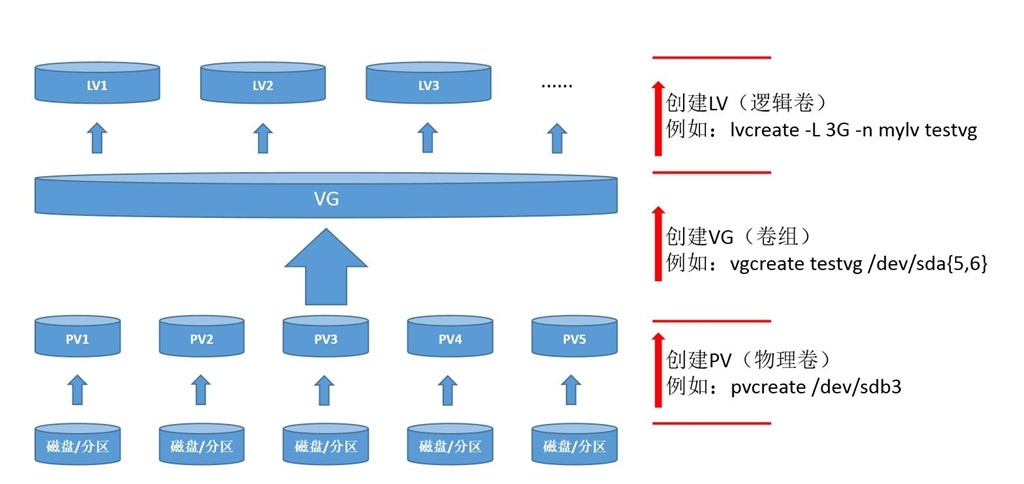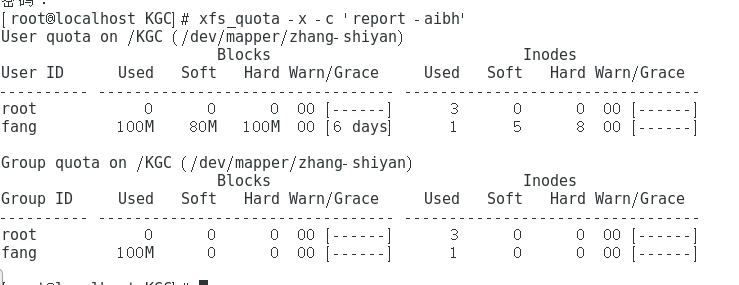catalogue
II. Common LVM management commands
Conditions for implementing disk quotas
preface
We often encounter A dilemma, that is, how to accurately evaluate and allocate the disk capacity. For example, hard disk A and hard disk B have 10G remaining capacity. At this time, I want to put in A file larger than 10G and how to use the remaining capacity without adding A new hard disk. This is the LVM we want to grasp.
1, LVM overview
LVM is a logical mechanism for disk partition management in Linux system. It is built on the hard disk partition, which can dynamically adjust the disk capacity and improve the flexibility of the disk while keeping the existing data unchanged.
Before understanding LVM, you must know several terms
PV (physical volume)
Physical volume is the basic storage device of LVM mechanism, usually corresponding to partition or hard disk. When creating a physical volume, a reserved block will be created in the partition or hard disk head to record LVM attributes, and the storage space will be divided into basic units (PE S) with a default size of 4M to form a physical volume.
VG (volume group)
A whole composed of multiple physical volumes is called a volume group, in which physical volumes can be dynamically added or removed.
LV (logical volume)
The logical volume is built on the volume group and has no direct relationship with the physical volume. For the logical volume, each volume group is a whole. A small space is cut out in the whole, and this space is the logical volume.
The specific relationship is shown in the figure

II. Common LVM management commands
| function | Physical volume PV | Volume group VG | Logical volume LV |
| Scan scan | pvscan | vgscan | lvscan |
| Create create | pvcreate | vgcreate | lvcreate |
| Display display | pvdisaplay | vgdisplay | lvdisplay |
| Remove remove | pvremove | vgremove | lvremove |
| Extend extension | vgextend | lvextend | |
| Reduce | vgreduce | lvreduce |
3, Create LVM
Experimental environment centosc7 4 system, add two 20G disks, set the partition, and modify the partition type ID to 8e
equipment Boot Start End Blocks Id System /dev/sdb1 2048 41943039 20970496 8e Linux LVM equipment Boot Start End Blocks Id System /dev/sdc1 2048 41943039 20970496 8e Linux LVM
We create physical volumes from these two partitions
[root@localhost ~]# pvcreate /dev/sdb1 /dev/sdc1
Partition to create
After completion[root@localhost ~]# pvdisplay view
--- NEW Physical volume ---
PV Name /dev/sdb1
VG Name
PV Size <20.00 GiB
Allocatable NO
PE Size 0
Total PE 0
Free PE 0
Allocated PE 0
PV UUID wwtSNy-24ex-Brof-5KBr-eiXE-6CcS-GBOGOx
"/dev/sdc1" is a new physical volume of "<20.00 GiB"
--- NEW Physical volume ---
PV Name /dev/sdc1
VG Name
PV Size <20.00 GiB
Allocatable NO
PE Size 0
Total PE 0
Free PE 0
Allocated PE 0
PV UUID PzwPUp-WAjf-XK1i-cWdO-wB5N-GsEN-egDs5n
The next step is to merge the two partitions into a physical volume [root@localhost ~]# vgcreate zhang /dev/sdb1 /dev/sdc1 zhang : Represents the name of the physical volume /dev/sdb1 /dev/sdc1: Represents the two partitions that need to be merged After completion[root@localhost ~]# vgdisplay view --- Volume group --- VG Name zhang Physical volume name System ID Format lvm2 Metadata Areas 2 Metadata Sequence No 1 VG Access read/write VG Status resizable MAX LV 0 Cur LV 0 Open LV 0 Max PV 0 Cur PV 2 Act PV 2 VG Size 39.99 GiB Combined size PE Size 4.00 MiB Total PE 10238 Alloc PE / Size 0 / 0 Free PE / Size 10238 / 39.99 GiB VG UUID lUyHcT-svfx-lalM-qNO1-LTW1-undV-d3D7a3 Our physical volume has been created
The next step is to divide the logical volume [root@localhost ~]# lvcreate -L 30G -n shiyan zhang -L 30G : The size of the created logical volume is 30 G -n shiyan : Defines the name of the logical volume zhang : Select which physical volume to divide the logical volume from complete root@localhost ~]# lvdisplay view my logical volumes LV Path /dev/zhang/shiyan LV Name shiyan Logical volume name VG Name zhang From which physical volume LV UUID gt7PBu-e5Ql-L6h6-AHfo-zMnB-1fIe-4NLhVH LV Write Access read/write LV Creation host, time localhost.localdomain, 2021-08-15 20:04:48 +0800 LV Status available # open 0 LV Size 30.00 GiB Logical volume capacity Current LE 7680 Segments 2 Allocation inherit Read ahead sectors auto - currently set to 8192 Block device 253:2
Next, define the file system as xfs format
[root@localhost ~]# mkfs.xfs /dev/mapper/zhang-shiyan
meta-data=/dev/mapper/zhang-shiyan isize=512 agcount=4, agsize=1966080 blks
= sectsz=512 attr=2, projid32bit=1
= crc=1 finobt=0, sparse=0
data = bsize=4096 blocks=7864320, imaxpct=25
= sunit=0 swidth=0 blks
naming =version 2 bsize=4096 ascii-ci=0 ftype=1
log =internal log bsize=4096 blocks=3840, version=2
= sectsz=512 sunit=0 blks, lazy-count=1
realtime =none extsz=4096 blocks=0, rtextents=0
We know that the disks in the Linux system are mounted. We need to mount the newly created logical volume to the required directory before we can use it
[root@localhost /]# mount /dev/mapper/zhang-shiyan KGC, Mount my logical volume to KGC Directory Note: This is only a temporary mount, and there is no restart. If you want to permanently mount, you can go back to my previous blog use df -h see /dev/mapper/zhang-shiyan 30G 33M 30G 1% /KGC This logical volume is ready for use
4, Extend logical volume
The steps are basically the same as above
1 First, the partition type to be extended ID Set to 8 e 2 pvcreate [New partition] Create a new partition as a physical volume Example: pvcreate /dev/sdb2 3 vgextend [The name of the volume group that needs to be extended] [New physical volume] Extend new physical volumes to volume groups Example: vgextend zhang /dev/sdb2 4 lvextend -L +20G /dev/Volume group name/Logical volume name Select the capacity and name of the extended logical volume Example: lvextend -L +20G /dev/zhang/shiyan 5 xfs_growfs /dev/mapper/Physical volume-Logical volume Enter the logical volume mount directory and refresh the logical volume online Example: xfs_growfs /dev/mapper/zhang-shiyan 6 df -h View expanded capacity
5, Disk quota
In linux system, because it is a multi-user and multi task environment, if a few users use a lot of disk space, it will lead to the normal use of other users. Therefore, it is necessary to manage and limit the disk space of each user.
Conditions for implementing disk quotas
Install xfsprogs and quota packages
Disk quota features
Scope: for the specified file system
Restricted object: user account, group account
Limit type: disk capacity, number of files
Restriction method: soft restriction, hard restriction
Disk quota overview
1 mount the file system in a way that supports the quota function
2. Edit the quota settings of user and group accounts
3. Verify disk quota function
4 view disk quota usage
Disk quota process
1 check whether xfsprogs and quota packages are installed first
[root@localhost /]# rpm -q xfsprogs xfsprogs-4.5.0-12.el7.x86_64 [root@localhost /]# rpm -q quota quota-4.01-14.el7.x86_64
2 add support quota function mount
[root@localhost ~]# vim /etc/fstab for editing
/dev/mapper/zhang-shiyan /KGC xfs defaults,usrquota,grpquota 0 0 /dev/mapper/zhang-shiyan Represents mounted physical and logical volumes /KGC Represents the mounted directory xfs Represents the file format defaults,usrquota,grpquota Parameters representing quota mount 0 0 Representative does not verify
3. Edit the quota settings of user and group accounts
Common parameters -x: Indicates that the expert mode is started. In the current mode, the quota system is allowed to modify management commands -c: Indicates that the administrator command is called directly -u: Specify user account object -g: Specify group account object bsoft: Set disk limit value bhard: Set hard disk limit value isoft: Set the soft limit for the number of disk files ihard: Set the hard limit on the number of disk files
Type this command xfs_quota -x -c 'limit -u bsoft=80M bhard=100M isoft=5 ihard=8 fang' /KGC/ -x,-c,-u The meaning is in the front picture limit : limit bsoft=80M : The soft limit is 80 M call the police bhard=100M : The hard limit is 100 M Cannot create more than 100 M File isoft=5 : File node, create 5 file alarms by value ihard=8 : The maximum number of file nodes to be created is 8 fang : Restricted user name /KGC/ : Mounted directory
4 verify disk quota function
chmod 777 /KGC Set the mounted directory permissions to maximum su -fang Login restricted users
Enter this command [fang@localhost KGC]$ dd if=/dev/zero of=/KGC/kcg.txt bs=10M count=12 It's worth me to KGC Create 12 directories with a size of 10 M Fake file
dd: write in"/KGC/kcg.txt" error: Disk quota exceeded Recorded 11+0 Read in Ten were recorded+0 Writing Due to my previous limit, the maximum number of files created is no more than 8, and the maximum number is no more than 100 M Capacity, so it cannot be created here
5 view quota usage
Enter the root user and enter xfs_quota -x -c 'report -aibh'

You can see the quota usage, user name, file node and quota capacity at a glance.
Other quota commands
xfs_ quota -x -c 'limit -u bsoft=80M bhard=100M fang' /KGC/ Limit disk capacity only xfs_ quota -x -c 'limit -u isoft=5 ihard=10 fang' /KGC/ Limit disk files only
xfs_ quota -c 'quota -uv fang' /KGC/ see fang User's disk capacity limit xfs_ quota -c 'quota -i fang' /KGC/ see fang User file limit
summary
In the production environment, we use disks more strictly. In the face of massive log files and multi-user operations every day, we need to allocate the use of disks more reasonably and restrict different users.